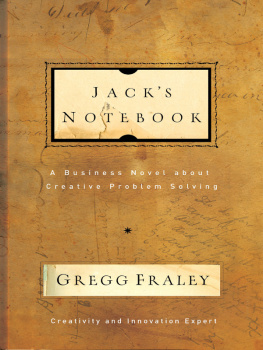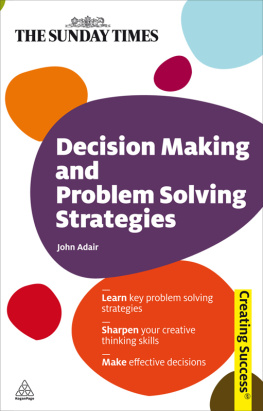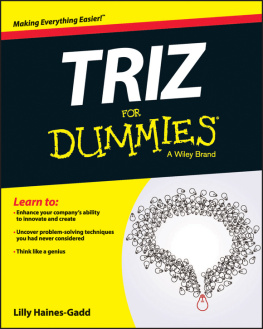About the Authors
Scott G. Isaksen, PhD, is President of the Creative Problem Solving Group, Inc., and Senior Fellow of its Creativity Research Unit. He is also a Professor of organizational leadership and management at the Norwegian School of Management and was Director of SUNYs (State University of New York) International Center for Studies in Creativity. He has authored or coauthored more than 185 books, articles, and chapters in books. He has conducted more than 1,800 programs and courses by working with more than 250 organizations and groups in more than 36 U.S. states or Canadian provinces and 26 different countries. He has served as a consulting editor for the journal of Creative Behavior since 1983. In 1996, he was awarded the State University of New York Chancellors Award for Excellence in Teaching.
His main interests and areas of expertise include building capabilities for leading innovation, applying Creative Problem Solving to business, establishing the climate for innovation and creativity, and understanding and leveraging style differences. He holds a master of science degree from Buffalo State College in creativity and innovation (1977) and a doctorate in curriculum design from the University at Buffalo (1983).
K. Brian Dorval is Founding Partner and President of Think First Serve, Inc., a management training and consulting company specializing in the use of creative-thinking, problem-solving, and performance improvement methods to help groups and organizations figure out new ways to grow. He has more than 23 years of experience helping people, teams, and organizations significantly improve their personal performance and business results. He has delivered more than 450 Creative Problem Solving, management coaching, and performance training sessions for companies in 20 countries around the world. He has also published more than 50 articles, chapters, and books on topics related to creative thinking, problem solving, and performance improvement.
In other performance-related areas, he is a USPTA (United States Professional Tennis Association)-certified tennis professional, who specializes in the mental game. He has worked with regionally and nationally ranked junior and college tennis players, as well as adults of varying levels, to improve mental toughness and enhance performance during competition. He conducts research on the topics of creative thinking, problem solving, mental imagery, and sports performance and applies the results to help people, teams, and organizations develop high-performance practices that stimulate growth and success. He is also Head Tennis Professional for Western New Yorks Shining Stars adaptive tennis program for children with autism. He holds a master of science degree from Buffalo State College in creativity and innovation (1990).
Donald J. Treffinger is President of the Center for Creative Learning, Inc., in Sarasota, Florida. His work focuses on the areas of creativity, Creative Problem Solving, problemsolving style, and gifted and talented education. He has authored or coauthored more than 60 books and monographs and more than 350 articles in a wide variety of professional journals in education and psychology. He began his career as a mathematics teacher in Buffalo, New York, and has subsequently served in several positions at the university level. He was a member of the Educational Psychology and Research faculty of Purdue University, Professor and Chairman of the Educational Psychology and Research Department at the University of Kansas, and Professor of Creative Studies at Buffalo State College. He has received the National Association for Gifted Childrens Distinguished Service Award and the E. Paul Torrance Creativity Award. In 2005, he received the Risorgimento Award from Destination ImagiNation, Inc., and the International Creativity Award from the World Council for Gifted and Talented Children. In 2009, he received the Executive Directors Award from the Future Problem Solving Program International. He has served as editor of the Gifted Child Quarterly (1980-1984), as Editor-in-Chief of Parenting for High Potential, NAGCs quarterly magazine for parents (19992007), and as a reviewer for numerous journals, and he is currently a member of the Editorial Advisory Board for the Gifted Child Quarterly. He holds an MS degree and PhD degree in educational psychology from Cornell University and an honorary LLD degree from the University of Winnipeg (Canada).
Acknowledgments
M any people have influenced our work in the field of creativity and Creative Problem Solving (CPS). Those who have studied and worked at the Center for Studies in Creativity (CSC), particularly Sidney Parnes, Ruth Noller, Angelo Biondi, Dorothy Hunter, Fern Innes, Grace Guzzetta, and the many who came after them, provided the context for our early interactions and learning. The founding scholars of our field, J. P. Guilford, E. Paul Torrance, Donald W. MacKinnon, John Gowan, Moe Stein, and others made many contributions to us and to our emerging field of inquiry. The faculty and many fine students we have had the honor to work with in many academic settings through the years helped us refine and develop our interest in learning, writing, researching, and teaching about creativity and creative problem solving.
Each of us has had numerous opportunities to work with many clients who helped us extend our learning and our service to the world outside the academic arena. Some of the key organizational clients who have helped us see the relevance of CPS to business and industry include Bill Lambert, Mary Wallgren, and Susan Ede of Procter and Gamble; Frank Milton and Trevor Davis from PricewaterhouseCoopers; Don Taylor, Chuck Brandt, and George Saltzman of Exxon; Tom Carter of ALCOA; Don Betty, Nancy Hann, and Mary Boulanger of Armstrong World Industries; Russ Ward and Christopher Goodrich from Datex-Ohmeda (now GE Healthcare); David Dunkleman of Weinberg Campus; Simon McMurtrie, Greg Dzuiba, Samantha Stead, Alf Tnnesson, David Thatcher, Jillian Bruhl, and Debbie Clark-Nilsson of International Masters Publishers; Rita Houlihan, Bruce Esposito, Ed Lynch, and Will Husta of IBM; Gideon Toeplitz of the Pittsburgh Symphony Orchestra; Suzanne Merrit of Polaroid; Aggi Heinz of Bertelsmann; Mike King and colleagues from Ogilvy & Mather; Allan Brooks, Andy Wilkins, John Rees, and Paul Wright from Bull Worldwide Information Systems; Peter Lyons, Charlie Prather, and Dick Comer of DuPont; and Stan Gryskiewicz, Anne Faber, and others at the Center for Creative Learning, Inc.
Some of our educational and academic clients in recent years have included Bill Littlejohn, Priscilla Wolfe, Bonnie Buddle, Jackie Pitman, Gary Collings, and the CPS team at Indiana State University; Carol Wittig and all the G/T (Gifted/Talented) and Ideas Specialists in the Williamsville Central Schools; Cindy Shepardson and Yvonne Saner in the Newark, New York, schools; Grover Young and others from the Holt, Michigan, schools; the CPS team from the Lakewood, Ohio, school district; Jennine Jackson, Marianne Solomon, and Kathi Hume from the Future Problem Solving Program; John Houtz, Giselle Esquivel, and Ed Selby at Fordham University; Pat Schoonover and her colleagues in OM (and now the Destination Imagination program); and Andi Williams, Jan Casner, Marion Canedo, Evie Andrews, and the late Leonard Molotsky from the National Inventive Thinking Association. These people helped us understand the crucial improvements that are necessary to keep CPS relevant and dynamic.
The many international scholars, practitioners, and clients with whom we have worked helped us understand the value and usefulness of CPS for other cultures, and in different ways. Marjorie Parker and Per Grohlt were the first to invite us to Norway. Luc De Schryver brought us to Belgium and the Netherlands. Wayne Lewis helped us learn about the United Kingdom and France, and Gran Ekvall and Rolf Nilstam introduced us to Sweden. Bob Swartz, Agnes Chang, Dennis Sale, Norah Meier, and others asked us to help them work on attaining the goal of thinking schools and a learning nation in Singapore. Lilian Dabdoub has brought us into Mexico and Helena Gil de Costa into Portugal. Anke Theile brought us into Germany. Guido Prato-Previde and Roberta Prato-Previde brought us into Italy. Many friends and colleagues in Canada have contributed actively to advancing CPS across North America, including Diane Austin, Lenore Underhill, and others from the Cowichan School Division in British Columbia; Tom Hengen and others in Saskatchewan; Ken McCluskey, S OHagan, and Phil Baker in Manitoba, Canada; and Gretchen Bingham, Gwen Speranzini, and Barbara Babij in different parts of Ontario, Canada.
Next page





